Is the internet a reflection of our best selves, or a funhouse mirror reflecting our deepest, often unsettling, preoccupations? The viral spread of content centered around taboo subjects, often presented with a veneer of humor, suggests a complex and perhaps troubling answer.
The digital landscape, a swirling vortex of information and entertainment, constantly churns out content that ranges from the sublime to the utterly bizarre. Recent observations reveal a disturbing trend: the normalization, and even celebration, of themes previously considered off-limits. Consider, for instance, the curious case of the "step sister" trope, which has inexplicably gained traction across various online platforms. What began as a niche interest has blossomed into a full-blown subculture, complete with its own memes, animated GIFs, and, alarmingly, "games." This content, often framed as comedic or lighthearted, subtly normalizes and desensitizes audiences to potentially harmful and exploitative themes. Platforms like TikTok, fueled by algorithms designed to maximize engagement, are particularly fertile ground for this kind of content. A video from Josh Rogers (@jarah30), for example, showcases a compilation of jokes and comedy referencing a "step sis getting stuck in the dryer". While the intent might be to elicit laughs, the underlying theme taps into a realm of discomfort. This is not an isolated incident, but a symptom of a broader phenomenon.
| Theme | Description | Platforms Affected | Impact |
|---|---|---|---|
| "Step Sister" Tropes | Content (videos, GIFs, games) exploiting familial relationships, often sexualized and presented with humor or titillation. Often focuses on the relationship between step siblings. | TikTok, Twitter, various meme communities, adult entertainment websites. | Normalization of incestuous themes, desensitization to exploitation, potential for psychological harm. |
| Shock Humor | Jokes and scenarios that intentionally offend or shock the audience, often using taboo subjects for comedic effect. | YouTube, TikTok, online forums, comedy websites. | Desensitization to offensive content, potential for promoting harmful stereotypes. |
| Exploitation of Vulnerable Individuals | Content that targets and exploits individuals for views or monetary gain. | TikTok, YouTube, various social media platforms. | Ethical concerns, psychological harm, can lead to bullying, harassment. |
The rise of this type of content is intertwined with several factors. The algorithms used by social media platforms, designed to maximize user engagement, often prioritize content that provokes strong emotional reactions, regardless of its ethical implications. This creates an environment where sensationalist and potentially harmful content can thrive. The prevalence of anonymity online also plays a role, allowing creators to share content without fear of accountability. Furthermore, the blurring of lines between reality and fiction, facilitated by the internet, can make it difficult for audiences, particularly younger ones, to distinguish between harmless entertainment and genuinely harmful content. The use of humor as a shield further complicates the issue, as creators often claim artistic license or comedic intent to deflect criticism.
The "step sister stuck in the dryer" scenario is just one example of this trend. The fact that such a premise can be packaged and presented as entertainment, finding an audience, is indicative of a deeper problem. It reveals a willingness to engage with potentially problematic themes, even if they are presented in a stylized or seemingly humorous manner. Andi's interaction with Rosalyn about her stepbrother, as reported, and her subsequent prank on Robby, demonstrates another level of the same problem. The focus on a young woman's relationship with her stepbrother is ripe for exploitation, and while seemingly harmless in isolation, it contributes to a pattern of content that can be quite harmful, given the right context.
The spread of "step sister" related content underscores the importance of critical thinking skills and media literacy. It's crucial for individuals, especially young people, to be able to recognize and evaluate the content they consume. This involves questioning the intent of creators, assessing the potential impact of the content, and understanding the strategies used to manipulate emotions and behaviors. The "When step sis really get stuckgif" is not innocent entertainment, even if it's used as a way to spice up a conversation. The use of animated GIFs adds another layer of complexity. While GIFs can be a fun and expressive way to communicate, the sheer volume of these particular GIFs makes it easier to stumble upon content that normalizes dangerous or unhealthy behavior.
Another element to consider is the creation and dissemination of user-generated content. The ease with which individuals can create and share content on platforms like TikTok and Twitter has led to an explosion in the volume of online content. This has created a need for greater platform responsibility. In the quest to maintain user engagement, social media algorithms may inadvertently promote harmful content, creating a cycle of exposure and acceptance. There is a clear relationship between the content platforms allow, how their algorithms work, and the kind of themes that take hold. The mere fact that someone creates a search query and receives results, even if they are meant to be humorous or satirical, is indicative of the content's existence, and potential popularity.
Furthermore, it is imperative to consider the potential consequences of normalization. Repeated exposure to content that trivializes taboo subjects can lead to a distorted perception of reality. Over time, these themes may become desensitized. This can lead to tolerance, and even acceptance, of behaviors that would previously be considered unacceptable. The presence of "Step brother step sister step mom" in the same search space is an immediate red flag. All three terms have potential for sexual exploitation and further emphasizes the need for increased regulation and content moderation. Alex's comments about Codey and Codey's response are another indicator of the need to address such issues. Similarly, the information related to the game "Friendslop the elder scrolls iv: Oblivion remastered horse race tests april 2025 4chan sharty hack and janitor email leak images" illustrates that inappropriate themes are not confined to a single type of media. The fact that such a specific search query, and the results it brings, is both informative and concerning.
The issue of content moderation is also a key consideration. While platforms have implemented policies to address harmful content, the sheer volume of material, coupled with the creativity of those seeking to circumvent these policies, makes effective moderation a significant challenge. The ability of creators to use humor or satire as a shield further complicates the process. Effective content moderation requires both technological solutions and human oversight. It must be responsive to evolving trends and adapt to the sophisticated tactics used to promote harmful content.
Moreover, the role of communities and networks in content dissemination cannot be ignored. Online communities, with their shared interests and values, can play a significant role in promoting or demoting content. This means that the actions of these groups are very important. The "28m subscribers in the memes community" mentioned in the context of this content is something that will need to be addressed. The fact that these large groups can spread content quickly means that platforms need to consider the possible negative impacts these groups might have.
While the internet offers unprecedented opportunities for creativity and connection, it also presents risks. The viral spread of potentially harmful content, particularly content that touches upon sensitive subjects, demands increased attention. This requires a multifaceted approach involving individual responsibility, media literacy, platform accountability, content moderation, and community awareness. The search for "Welcome to step sister stuck games!" indicates a level of demand for such content that should be immediately concerning. We need to reevaluate the role that such content plays in our society and create a digital environment that is safer and more responsible.
The issue is not merely about stopping the creation or sharing of this content. The goal is to nurture a society where individuals are equipped with the skills and knowledge they need to navigate the digital world safely and critically. We also need to promote a culture of respect, empathy, and responsible online behavior. It is up to us to be aware of these themes and work toward solutions. Only then can we use the internet's creative power in a way that builds up society and avoids the hazards that are inherent in it.


